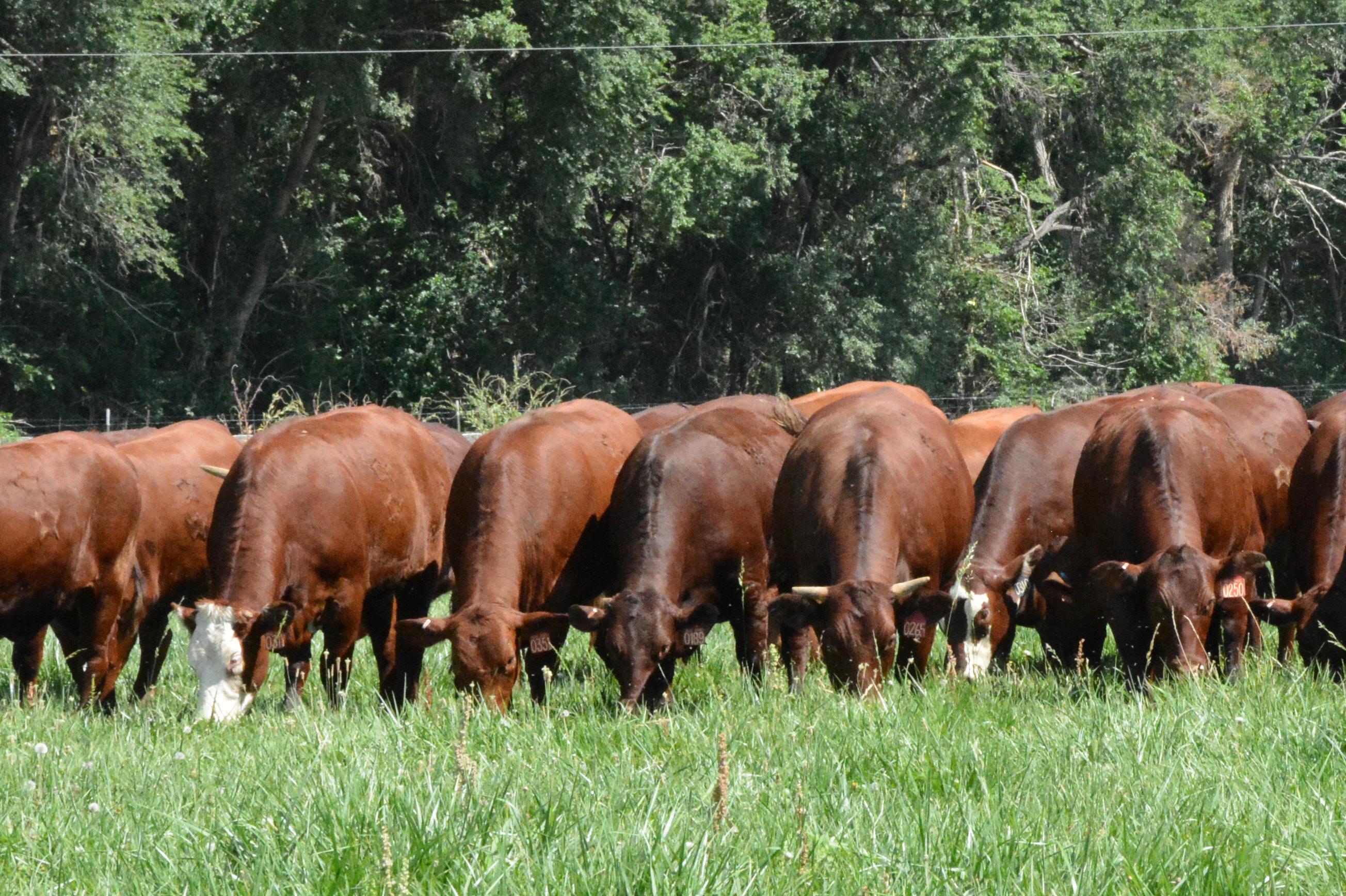
28 minute read
hour drive to Red Doc Farm
More confidence and profit from pasture to plate
Welcome to Red Doc Country! 2022 marks our 18th annual Red Doc Farm “Red Hot Bull Sale” at our headquarters in Bosque, NM. The Sanchez family continues to breed great Santa Gertrudis as was the vision of the late Dr. Roland K. Sanchez. These 2021 offering calves overcame a spring drought and turned up the performance when the summer rains finally returned. This one of the strongest offerings of Red Doc bulls across the board as multiple generations of performance and efficiency tested genetics have been mated to add value to commercial cattleman’s calf crops. Red Doc Farm continues to lead the Santa Gertrudis breed with feed efficiency GrowSafe EPDs. Red Doc Farm has been feed efficiency testing for over 5 years now and has the largest database of GrowSafe tested Santa Gertrudis cattle in the breed. Red Doc Farm has long been known for its high-quality carcass cattle, now provides the additional confidence to compare our cattle across all major beef breeds. The Red Doc cattle core traits remain consistent producing quality grade efficient genetics that are adaptable to various environments. Our top-quality sires, donors, and replacement females meet the needs of the cattleman and return greater profits in tough environments and on the rail, the evidence and the testimonials speak. The Red Doc cattle lines rise to the top in sales worldwide and the Red Doc program has built equity in numerous registered and commercial herds. The 2022 bull offering ranks alone at the top of the Santa Gertrudis Breed for carcass and profitability with 100% choice genetics, average yield grade of 1.95, average cost of gain of $0.95, and with an average feed conversion of 5.30 lbs. feed/lb. of gain. The Red Doc Farm Sanchez family has been breeding Santa Gertrudis cattle for 43 years and with God’s blessing we plan to continue, developing, selecting, breeding, and validating sustainable beef genetics for years to come. We strive to provide practical data to assist you in selecting sale cattle with a blend of real raw data, the latest genomically enhanced EPDs, and selection indices. Phenotype, fertility, function, rapid growth, and easy fleshing remain our core criteria. Our emphasis on selecting high marbling, efficient, heat tolerant bulls allows registered and commercial men to have more confidence and profit form pasture to plate.
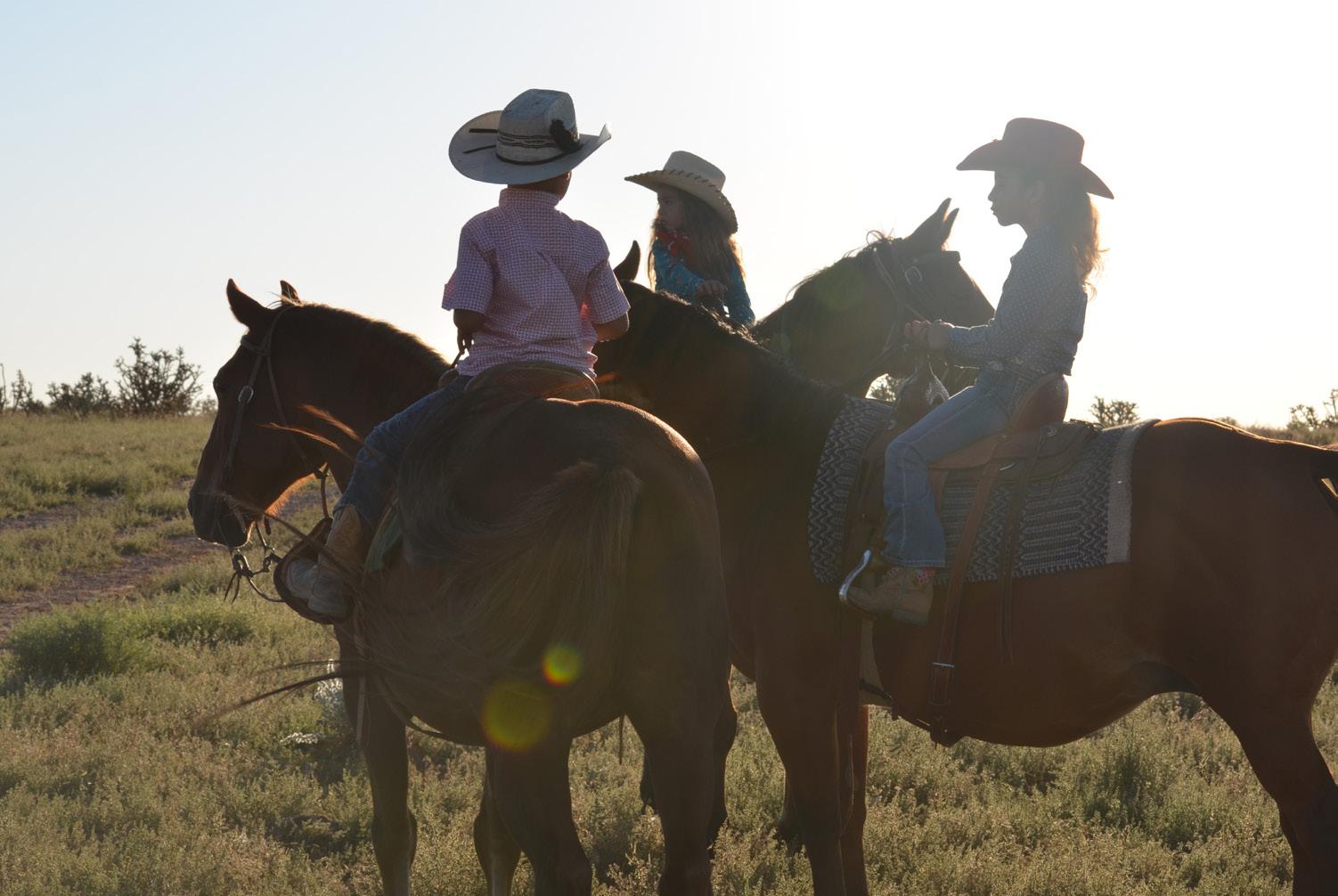
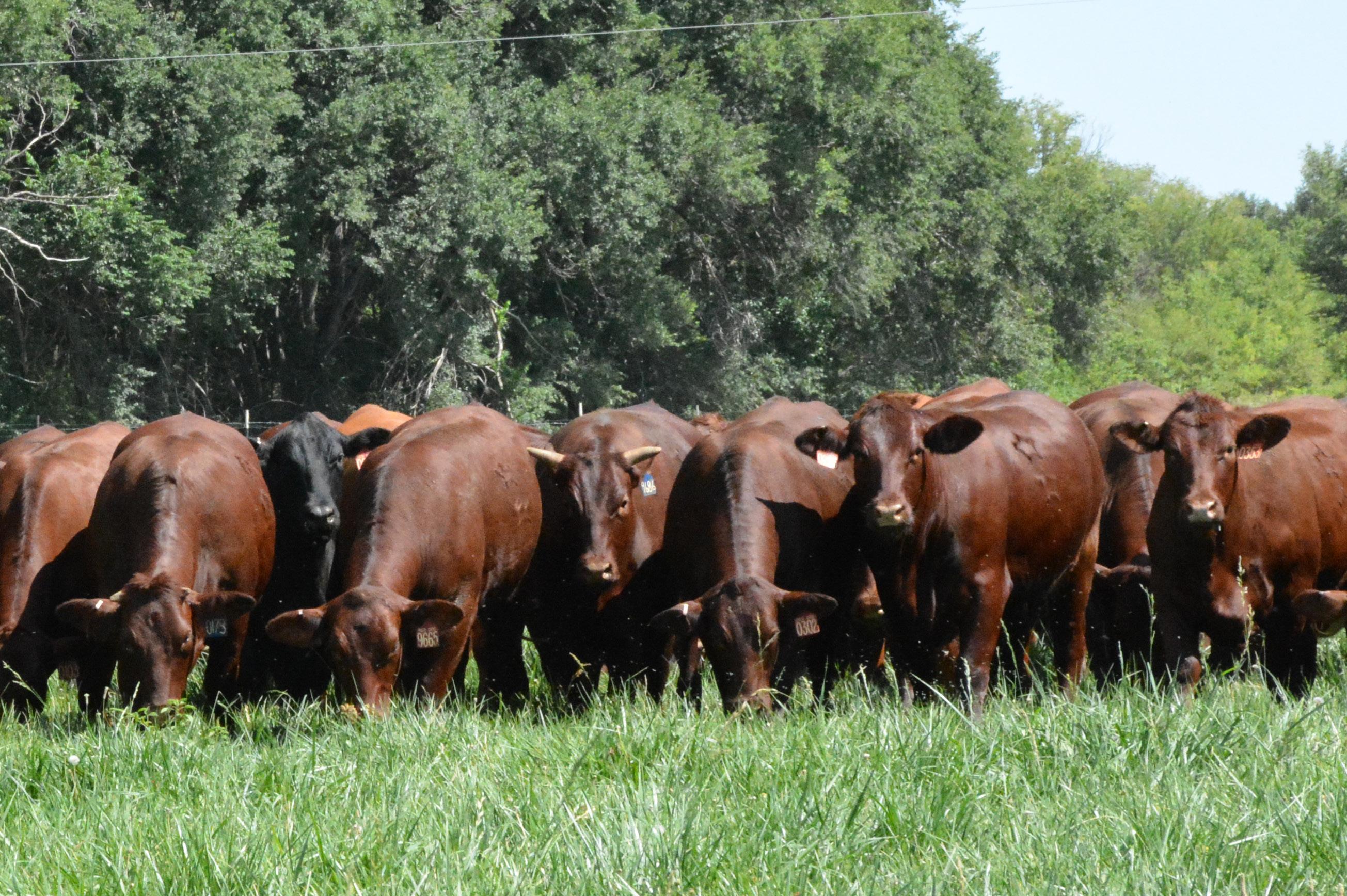
Schedule of Events FRIDAY, APRIL 1, 2022 Sale Day Contacts
6pm MST Dinner and entertainment
7pm MST Elite Cut Female Sale Scooter Sanchez........505.980.5093 Florian Sanchez.........505.379.7781 Emilio Sanchez...........505.507.7781 John Ford.....................361.522.2134
SATURDAY, APRIL 2, 2022
7:30am Red Doc Direct update meeting- Yucca Veterinary Medical Center, Belen, NM
9am Cattle available for viewing
11:30-1pm Lunch and mariachi band
1pm Live-closeout auction- Red Hot Bull Sale followed by RMSGA Spring Runoff Sale

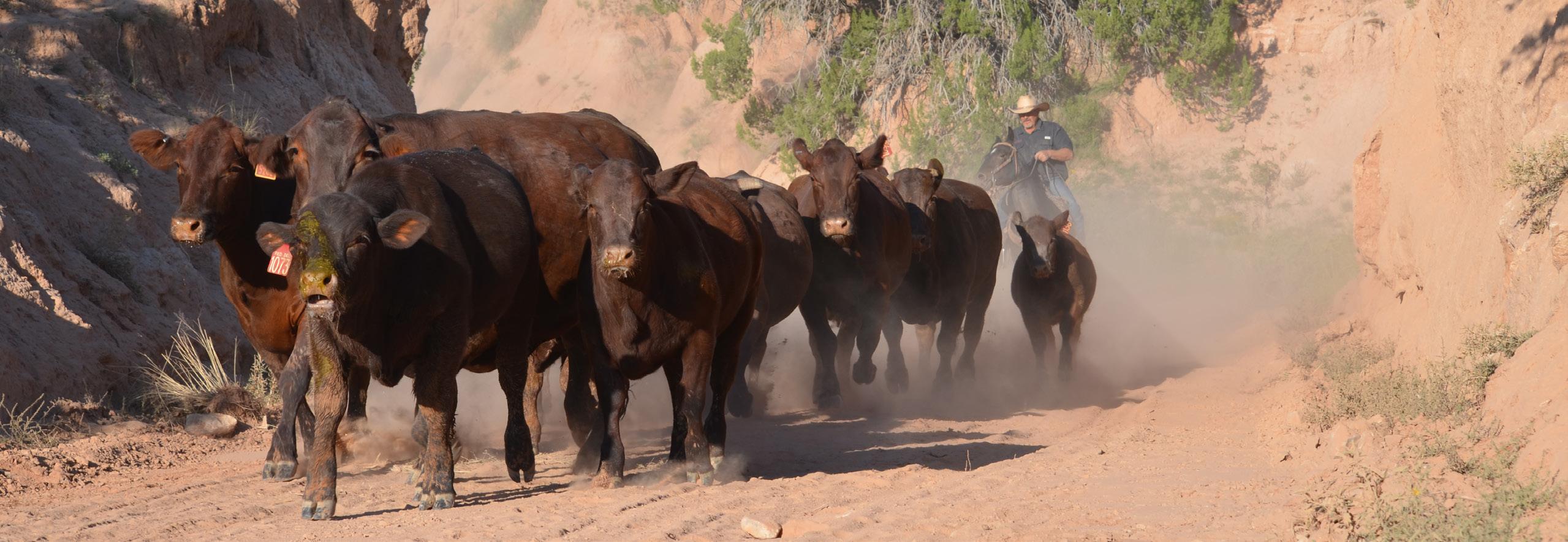
From Albuquerque
Travel I-25 South towards Belen, approximately 35 miles. Take exit 190, heading North. Make first right toward highway 116, heading South. Continue on highway 116 for approximately 6 miles. At the Cristo Rey Catholic Church, make a left on highway 346 heading East. Red Doc Farm will be approximately a half mile on your right. Look for a large red barn!
Commercial and Private Aircraft
Commercial-Albuquerque International Sunport 40 minute drive to Red Doc Farm Private- Belen Camino Del Llano Regional Airport 15 minute drive to Red Doc Farm
I-25 Albuquerque
Belen
116
346
Hotel Accommodations
Baymont by Wyndham- Belen, NM
For those who want to be near the sale 2110 Camino Del Llano, Belen NM 87002 (505)861-5000 (refernce RED DOC for special rate) 12 minute drive to Red Doc Farm
Hotel Chaco
For those who want luxury, near historic district 2000 Bellamah Ave NW, Albuquerque, NM 87104 (505)246-9989 1 hour drive to Red Doc Farm Sheraton Albuquerque Airport Hotel
For those who want to be near the airport 2910 Yale Blvd. SE, Albuquerque, NM 87106 (505)843-7000 40 minute drive to Red Doc Farm
Isleta Resort and Casino For those who want fun and entertainment 11000 Broadway Blvd. SE, Albuquerque, NM 87106 (505)724-3800 30 minute drive Red Doc Farm

Red Doc Farm would like to recognize and thank our tremendous team for all their hardwork. We have a very talented team who brings so much to our operation. Our team must constantly switch gears. The project they are working on today might be completely different than the one they were working on yesterday but they graciously take on the challenge and succesfully execute it. On a normal day at Red Doc Farm, you will find our team welding, farming, fixing small equipment, fixing large equipment, tagging calves, putting out feed, moving cattle, branding, renovating buildings, planting, laser leveling, irrigating, prepping for large events, representing the operation at expos- and the list goes on! To put it simply, our team wears many hats and does it exceptionally well. We are very grateful for each and every talent and skill these guys and gals contribute to making Red Doc Farm a success. They truly work year round and around the clock and we could not do it without them!
To help each buyer find the bull that suits their operation best, Red Doc Farm has provided as much information as possible to help aid in your decision.
From the standpoint of any association, you hope to be able to add value to your membership. While we continue to strive for that goal, you naturally have members that provide as much or more value back to the association itself. Red Doc Farm is truly that of the latter. A family operation in every sense of the word, Red Doc continues to push the envelope for the Santa Gertrudis breed, leading the way in data collection, progressive thinking, and a real-world animal the commercial cattleman can make a living off of no matter their geographic location. In studying Santa Gertrudis pedigrees, you quickly find Red Doc animals throughout the lineage of many of the most influential modern-day cattle, and monthly chart the brand across trait leaders up and down the breed’s registry. In seeing these cattle in person, you quickly find out why. Red Doc Santa Gertrudis are some of the most progressive in moderation, meat animal shape, feet and leg structure, and a build that will impress the most scrutinizing cowman of any breed. Santa Gertrudis Breeders International remains steadfast in being an industry leader, providing a genomically enhanced product for membership and commercial customers which ensures the most accurate and available information within the industry. Along with a comprehensive genetic evaluation, our membership continues to put pressure on traits that matter, providing Santa Gertrudis cattle that are fertile, growthy, and can not only be long lasting and hardy in the pasture, but also provide added value when placed in the supply chain. Buy with confidence in this breed and program knowing these cattle are backed by years of cowboy logic with the data collection and science needed in today’s industry.
Webb Fields Executive Director Santa Gertrudis Breeders Int’l

5
Docility scale
Four and five score bulls are nervous and do not like to be in close quarters with people on foot- but they are great for big range operations.
One and two score bulls are calm and easy to walk up to with feed.
3 1
Three score bulls have an average disposition and make up a large number of Red Doc bulls.
Santa Gertrudis Breeders International’s genetic evaluation is one of the most comprehensive among the Bos indicus influenced breeds ensuring profitable genetics can be selected for your operation. Over the past 8-year period, Santa Gertrudis breeders have increased selection pressure on traits that have a positive influence on profitability. Profit starts with a live calf and increases when industry end-point targets are hit. Regardless of your marketing strategy, selling by the pound at weaning, retaining ownership and grid-marketing, establishing a consumer direct market, or taking advantage of the replacement female market, Santa Gertrudis genetics ensure that herd goals can be reached. SANTA GERTRUDIS are DATA DRIVEN and PROFIT PROVEN.
Reg# 20130972 Calved: 02/08/13
Weights BW WW Scan WT ADG SC 90 702 1200 4.46 42
Birth Weight (BW) is expressed in pounds and predicts the sire’s ability to transmit birth weight to his offspring as compared to the average Santa Gertrudis sire.
Weaning Weight (WW) is expressed in pounds and predicts the sire’s ability to transmit pounds at weaning to his offspring as compared to the average Santa Gertrudis sire.
SGBI Expected Progeny Differences
Expected Progeny Differences, EPDs, are the prediction of how future progeny of each animal are expected to perform relative to the progeny of other animals listed in the SGBI database. EPDs are expressed in units of measure (plus or minus) for each trait being evaluated and are calculated utilizing pedigree and performance information. SGBI is a leader in the adoption and implementation of cutting-edge genetic technology. In 2013, SGBI released the first genomic-enhanced expected progeny differences (DNA verified) for Bos indicus-influenced cattle. The inclusion of DNA into the breed’s EPD calculations (GE-EPDs) has resulted in information that is more accurate and predicable than a pedigree and performance prediction alone. The association has access to thousands of performance verifying DNA samples. In addition, to being the first Bos indicusinfluenced breed to offer GE-EPDs, SGBI was the first beef breed to implement single-step methodology for the incorporation of BW WW genetic information into the genetic evaluation. This approach maximizes use of data reported on all animals throughout the pedigree and greatly improves the EPD accuracy.
EPDs 1.52
YW Milk Fat REA Marb REA/ CWT 12.2 16.3 -0.1 0.21 13.92 4.2 0.00

SGBI Indices
SGBI offers three selection indices for cattleman use. Indices are multi-trait selection tools designed to assist cattle producers by adding simplicity to genetic selection decisions. Indices provide an estimate of how future progeny of each sire are expected to perform, on average, compared to progeny of other sires in the database if the sires were randomly mated to cows and the calves were exposed to the same environment. SGBI’s indices provide performance insight to 3 beef production business models. The results are reported as a percentile ranking for each index.
Balanced Index: This index assumes that producers are keeping replacement heifers from the bulls they purchase. It further assumes that producers are either 1) marketing carcasses on the grid or 2) that buyer of their feeder calves base pricing on feedlot and carcass performance. This selection tool is designed to assist cattlemen who retain ownership through the feeding phase or market their calf crop to buyers focused on feedlot performance and/or carcass quality. Cow/Calf Index: This index assumes that producers are keeping replacement heifers form the bulls they purchase. However, it assumes all calves are marketed at weaning or soon thereafter. It further assumes that feeder calf buyers don’t base decisions on feedlot or carcass performance, making these traits less relevant to profitability. Producers marketing their calf crop at weaning, by the pound, would utilize this index when making selection decisions.
Terminal Index: This index assumes that producers are not keeping replacement heifers from the bulls they purchase. It assumes that producers are marketing carcasses on the grid, making carcass traits relevant to their business. This index fits operations using Santa Gertrudis bulls as terminal sires and retaining ownership of the calf crop through the feeding phase.
Index
Balanced Cow/Calf Terminal 1 1 1
FEED EFFICIENCY
Red Doc Farm is one of the only cattle operations in the country currently offering an actual cost of gain on each individual bull. Our calculations are generated off our actual average feed cost “per pound as fed” at $180/ton. The COG (cost of gain) calculations are based off Grow Safe generated average daily gain (ADG), dry matter intake (DMI), and days on feed extrapolated over a 200 day feeding period.
Feed:Gain
Grow Safe Efficiency EPDs Conversion Cost of gain RFI ADG DMI per lb. -0.000 -0.000 -0.000 5.54 $0.58


You can’t manage what you don’t measure.

What is the value of efficiency?
Producing cattle that can be successful from the mountain tops, river valleys, calving pastures, feedyards and variable climates and conditions can be challenging. Developing a pathway for success is paramount and providing information on each animal has become a necessity. But the simple true is you can’t manage what you don’t measure” and at Red Doc we believe in measuring our genetics for performance.
We’ve been measuring cattle, for Feed Efficiency since 2017, with the Vytelle “Sense” – Grow Safe technology to help us increase genetic potential in RFI, to correspond with our other trait management.
Why measure?
• Feed costs account for approximately 70% of production costs • It is possible to reduce feed costs by 10-15% • Residual Feed intake (RFI) has been shown to be 35-40% heritable • We can back up our claim to providing “DATA Driven” results and back those results up. • Breeding Sires are selected for Low RFI. • Replacement Heifers are selected out of our annual calf crop. Years of efficiency focused breeding has provided us with pedigrees that are saturated in generations of efficiency.
RFI is an important part of our genetic selection…. Creating more efficient animals with better predictability. RFI is the measured difference between what an animal was expected to intake for a given level of production for maintenance and growth, and the actual feed consumed. Low RFI cattle are efficient because they eat less than expected. While high RFI cattle are inefficient because they eat more than expected. Low RFI cattle can reduce... Feed intake by 12% or more Methane production by up to 30% NPK by up to 17%
Red Doc Farm is one of the only cattle operations in the country currently offering an actual cost of gain on each individual bull. Our calculations are generated off our actual average feed cost “per pound as fed” at $253.43/ton. The COG (cost of gain) calculations are based off Grow Safe generated average daily gain (ADG), dry matter intake (DMI), and days on feed extrapolated over a 200-day feeding period.
Red Doc is creating Genetics that meet the challenge of a growing global protein demand. Selecting genetics using Vytelle Sense and Insight Technology that are efficient and are environmentally sustainable. Finally, they are committed to producing genetics the provide greater economic returns for their customers. Sires like Red Doc En Vivo 8343 exemplify this effort. Genetics that provide Industry leading residual feeding intake and average daily gain in the Vytelle Insight Database while providing choice beef in a sustainable manner. In the end it’s about driving profitability, predictability, and sustainability.

I believe last year’s sale catalog letter started off with something about the commitment Red Doc Ranch has placed on data collection…and the value bull buyers should place on it. If you’ve read this far, rest assured that the pages that accompany this letter are the best this industry has to offer given the market climate we are enduring. Over the past 12 months, I have regularly checked two sources of information: the US Drought Monitor, and the grain markets. Quite frankly, neither have been particularly rosy for the beef industry. However, if there ever was a time in history to be resilient with your genetic selection, it’s now!
Without question, cattle that can ‘do more with less’ have never offered more value to the beef industry than they do today. Let’s do some cowboy math: if it takes 100 bushels of corn to finish a feedlot steer, that’s $750 in today’s market. A 10% reduction in Dry Matter Intake (DMI) would make that same steer consume 90 bushels of corn worth $675. That’s a feed cost savings of $75 per head. Multiply that over 20 head per year ($1,500) for 4 years owning the bull, and you’ve saved $6,000 on steer progeny alone. Coupled with that, the research suggests that the same bull’s daughters will consume less forage, stretching hay and pasture supply for the same level of maternal performance. The addition of Grow Safe feed efficiency data to this set of bulls in 2019 could not have come at a better time!
I’ve been analyzing the information collected from Red Doc Ranch since 2015, attempting to present buyers the information they demand…in a form they can understand. The Red Doc Ranch team shows you every data point they collect! That being said, I would still urge potential buyers to use EPDs at the forefront of their selection process when they are available. They are still the best tool in the box for evaluating genetics. The top end of these bulls are incredibly efficient, numbers that would compete with elite genetics in other breeds collecting the same information. As usual, the carcass attributes of Red Doc bulls are unprecedented in the Santa Gertrudis breed; they can grade Choice or better, have muscle, and all within a window of acceptability on fat cover. Best of luck to the Red Doc crew, the beef industry certainly appreciates your efforts.
Best regards, Patrick Wall Area Beef Field Specialist – SE Iowa PAW Livestock, LLC Marion County Extension Office 210 N. Iowa St., Knoxville, IA 50138 O: 641-842-2014 C: 515-450-7665

Project update: Utilizing the Santa Gertrudis breed as a model for Critically Evaluating Heterosis in Intermountain West Beef Systems Dr. Matthew Garcia Utah State University Beef Specialist
When I was approached to write an update on the SGBI and Utah State University heterosis collaboration, I was somewhat surprised that this collaboration is now going into its fifth year! The original intent of this project was to reintroduce an evidence based heterosis project to the industry as well as identify or dispel any concerns that there may have been in using the Santa Gertrudis (SG) breed in a crossbreeding program. Since the inception of this project we have seen dramatic increases in weaning weights, efficiency in the feedlot and increases in carcass quality and composition. In this article I will briefly describe some of the projects and results in which Santa Gertrudis are being utilized.
Feedlot, Implant and Mineral Studies:
One of the original intents of this study was to evaluate how Santa Gertrudis influenced cattle would perform in the feedlot. In year two we found that Santa Gertrudis cattle were using 13% less feed to get to finishing than their Angus (AN) influenced counterparts. I’m happy to say that we have finished two more groups of steers and that number has remained the same. As a result of these feeding trials it was decided that Santa Gertrudis cattle would also be involved in a implant study in which cattle received no implant, one implant, two implants. Results of the implant study revealed that there was no significant difference in gain between SG and AN that were implanted and no significant difference in non-implanted steers. Furthermore, there was almost an $80 economic incentive to implanting versus not implanting SG steers. A second study is currently being completed that looks at multiple implant effects on feedlot performance and carcass quality.
Carcass Studies:
Another major objective of this study was to evaluate how SG influenced steers would compare in regards to carcass quality and composition. We have currently collected carcass data on two years of steers and the results are promising. There was no discernable difference in marbling scores between AN and SG steers. However, AN steers marbling scores seem to be more affected by implanting than SG steers and SG steers have averaged a 2.5 YG while AN steers have an average YG of 3.2. We are currently feeding another group and expect additional data this summer.
Disposition and environmental compatibility evaluation:
One of the initial concerns with Utah producers dealt with incorporating Bos Indicus genetics and the subsequent effects on temperament and the ability to deal with harsh northern Utah winters. When evaluating temperament, every trial that has been conducted has measured exit velocity out of the chute. Santa Gertrudis steers and AN steers have shown no significant difference in exit velocity and there have been no temperament issues noted by researchers or the farm crew. When evaluating environmental compatibility, there have been no issues calving or keeping calves alive when calving in February. Since the inception of the project there have been six SG calves lost during calving season, but none was due to temperature acclimation.
Cow Longevity and Performance
While this part of the project is still in its infancy, female longevity was a major issue that the project wanted to address. The idea was that by incorporating SG genetics into the herd, that we could potentially get more compatible genetic predisposition in a forage variable production environment and subsequently increased longevity due to the Brahman influence of the SG breed. At the present time, USU is still in the building phase of our SG female herd base. Currently, we have a group of F1’s that three year olds that are currently calving for the second time and a larger group of 2 year olds that are calving for the first time. As we go forward we will continue to incorporate replace F1 SG influenced heifers into the base herd. Unfortunately, due to drought and loss of leases last year the USU herd was slightly reduced. However, our ultimate goal is to have 50-60 high quality F1 females in the herd that we can track for an extended period of time to evaluate environmental compatibility, cow effect on calf performance and longevity.
Producer buy in and incorporation of Santa Gertrudis Genetics:
When this project began there was possibly 1 or two individuals using SG genetics in Utah. There was once again, a producer concern about incorporating SG genetics into their herds. As such a concerted effort was made to incorporate research findings of this project into extension programs statewide and regionally. To date this project has been presented in 16 counties and 9 zoom presentations at the regional or national level. As a result there has been a significant increase in the number of SG bulls being brought into Utah and the number of producers incorporating SG genetics into their herds.
Summary:
The collaborative efforts of USU and SGBI have been very beneficial and productive. Not only have the collaborating agencies benefitted, but producers in this region have also benefited by being re-introduced to heterosis and the benefits that SG cattle can bring to their operations. The current collaboration has addressed concerns producers had by producing and presenting scientific and empirical evidence of the benefits of incorporating SG genetics into a breeding program in the intermountain west. As such we hope to continue our collaboration to generate more evidence of SG benefits in a cow calf operation, feedlot, carcass characteristics and female longevity. Utah State University has already made a breeding plan to use SG genetics again this year and due to the benefits to production and research, we can envision using SG genetics well into the future.

Bidding Each animal will be sold to the highest bidder without reserve. Minimum bids start at $2,500. The auctioneer (or sale manager) will settle any dispute as to bids, and his decision on such matters shall be final. Terms
Each animal becomes the risk of the purchaser as soon as sold, but it shall be the obligation of the seller to see that animals are fed and cared for, until loaded for shipment or until the expiration of seven days after the sale, whichever occurs sooner. After seven days a maintenance fee of $2.00 per day will be assessed until pickup unless Red Doc Farm is arranging trucking. Sight Unseen Purchases Buyers may purchase cattle through Red Doc Farm personnel at auction or private treaty without viewing the cattle. For sight unseen purchases, the buyer has the right of inspection at the time of delivery. If the animal is deemed unsatisfactory, it may be reloaded and returned to Red Doc Farm. If the animal is deemed unsatisfactory within one week of purchases, the buyer at their expense will return the animal to Red Doc Farm for a refund of the purchases price. All International Buyers will be responsible for all exportation, health certificates/ international documents, feed, and transportation costs during the exportation process and outside of the U.S.A. International transport fees are as follows:
1 head $400 3-4 head$300 2 head $350 5+ head $250 Cattle purchased through sale will be maintained at no cost to the buyer for 30 days. After the thirty day time frame a fee of four dollars a day, per animal will be enforced. Certificate of Registry A copy of the registration certificate will be furnished to the purchaser for each registered animal once proper settlement has been made. For Registered Breeders, all transfer costs will be at Red Doc Farm’s expense. Health
Interstate Health Papers suitable for interstate shipment will be furnished on all animals. All lots will be ready to ship at time of sale. Announcements Any changes from the information of any kind in this catalog will be provided in a sale day supplement sheet or announced from the auction block and such information shall take precedence over cataloged information. Breeding Guarantee All animals are guaranteed to be breeders with the exception of, a) calves under 14 months of age that have not passed a fertility test: b)animals shown by purchaser after sale in which the breeding guarantee (if any) shall be agreed upon between the seller and the buyer: c) injury or disease occurring after sale; d) gross negligence or willful misconduct on part of the purchaser. Any bull which settles cows by natural service and passes a fertility test made by competent veterinarians, mutually agreed upon by buyer and seller, during any six-month period of trial (provided for in paragraph 2 of the section of these sales terms and conditions entitled “Option and Privilege of Return and Adjustment”) shall be considered a breeder. Options and Privileges of Return or Adjustment All claims for adjustment or refund must be made in writing within three months of the sale date. In the event an animal is claimed to be a non-breeder, the animal may be returned to the farm of the seller with prior arrangements if in good condition and complying with health requirements of the seller’s state. The seller shall be entitled to a six month trial following the return of the animal in which to prove that the animal is a breeder. If the seller proved that animal to be a breeder, it shall be the obligation of the purchases to take delivery of the animal and pay all expenses, including but not limited to transportation, feed, and medical expenses. If the animal is not proved to be a breeder, the seller shall, at the option of the buyer, replace the animal with another of equal value or issue credit for the initial selling price. If any animal is sold and through blood typing is proven to have incorrect parentage, as represented by the certificate of registration, and for which parentage can be determined, the seller shall be obligated to make a satisfactory adjustment on the purchase price to the buyer, refund the purchase price or issue a credit for the initial selling price upon the return of the animal to the farm of the seller.
Rights and Obligation The above terms and conditions of the sale shall constitute a contract between the buyer and seller of each animal and shall be equally binding upon both. Other than the guarantees and warrantees stated above, and on other warranties or guarantees expressed or implied. Each sale or resale of an animal constitutes a separate transaction. Neither Red Doc Farm, the Sale Manager nor any other person connected with the management of the sale, assumes any liability, legal or otherwise. Partnership Bull Contract All partial interest bulls are guaranteed to produce freezable quality semen. If a partial interest bull has not produced freezable quality semen within 6 months of sale date, the buyer(s) at their option may be refunded the total purchase price or be issued a credit for the initial selling price. On all consigned bulls, Red Doc retains the right to collect semen on all bulls for in herd use for the life of the bull at Red Doc’s cost and the owners’ convenience. Red Doc retains the right to ¼ semen interest in each bull in sale with no possession. As purchaser of the bull, you own 75% semen interest and control semen sales and full possession of the bull. All parties with a semen interest will be allowed to collect and store semen for in-herd use and access required AI certificates with no obligation to others with a semen interest.
EPDs
EPDS are current as of March 10, 2022. Updated EPDS can viewed online at santagertrudis.com


Reg# 20206972 Calved: 10/6/2020
Measurements BW WW Scan WT ADG SC
65 518 1078 3.81
REA IMF
Ultrasound REA/ CWT Backfat YG
13.85 5.21 1.28 0.22 1.47
QG BW WW
EPDs YW Milk MB
1.4 22 24 -1 0.45
Grow Safe Efficiency EPDs Conversion Feed:Gain 4.8
Cost of gain per lb. Index
Lit 0504 Red Doc ET
Horned Docility:1
sire
Red Doc El Sueno 8020
dam
Red Doc 7111


Sire, Red Doc El Sueno 8020
LOT LOT 1

Red Doc Lit 0504 is perhaps the most viewed bull in the Santa Gertrudis breed by cattleman in 2022. This bull has been on display at Oklahoma Cattlemen’s Congress, NCBA, and Houston Livestock Show and Rodeo as Red Doc’s poster bull and earned the cover page this year. Red Doc Lit 0504 redefines how far Donor Dam, Red Doc Sabe 7111 we can take muscling and easy fleshing. This bull is the real deal with a 6.0 ADG, 13.8 REA, 5.2 IMF, 0.21 BF and an impressive 1.28 REA/CWT carcass. Red Doc Lit 0504 has a marbling EPD of 0.45 and more importantly is out of both top marbling sire Red Doc El Sueno 8020 and Red Doc 7111. The balanced dataset indicates this young sire is a nice fit for a variety of breeding programs. 8 EPDs in the Top 20%, including a Marbling EPD in the Top 1%, signify this bull’s offspring will fit the needs of today’s beef industry. This bull hits all the marks for a foundation herd sire for the progressive seedstock producer. With balanced EPDs backed by solid performance data , we are proud to offer such a lit breeding piece and an investment opportunity. *Red Doc retains 50% semen interest unless sold for $25K or more 12


Reg# 20210121 Calved: 2/7/2021
Measurements BW WW Scan WT ADG SC
83 808 1385 4.48 42
Grow Safe Efficiency EPDs
RFI ADG DMI
0.263 0.032 0.377
Conversion Feed:Gain
Cost of gain per lb. 5.91 $1.06
REA IMF
Ultrasound REA/ CWT Backfat YG
16.11 7.62 1.16 0.4 1.88 QG
Red Doc Trump’s Apprentice 1078 can be a great reset to your cow herd. This young yearling bull earned his way to the front of the catalog based on stellar performance, carcass quality, and powerful phenotype. No surprise how the easy fleshing lines of Red Doc Trump 5127 and dam Red Doc Madre 2081. Here is half sibling to Red Doc El Sueno 8020, out of Red Doc 2081, who has a 352-day breeding interval. Red Doc Madre 2081 has solidified her place in Red Doc history. For those breeders eager to bring in growth and carcass quality, look no further and look beyond the EPDs on this bull. Red Doc Trump’s Apprentice 1078 had a 808lb WW,1385lb YW, 16.11 REA, and 7.622 IMF with 0.4 BF. Red Doc Trump’s Apprentice 1078 ranked 1# in our entire offering for USDA carcass profitability in the 2022 bull offering.
Balanced Index
Cow/Calf Terminal
50 65 40
BW WW
EPDs YW Milk MB
-0.2 4 9 3 0.05
Trump’s Apprentice 1078 Red Doc
Scurred Docility:2


LOT2
This young herd sire had an adjusted IMF of 9.41 and calculated YG of 1.88. This bull enters uncharted territory for Santa Gertrudis genetics and brings the beef industry a heat tolerant out cross to add pounds of prime genetics to your calf crop. The pioneers of polled Santa Gertrudis would be proud of this young deep cherry red performance bull.
sire
Red Doc Trump 5127
dam
Red Doc Madre 2081

Sire, Red Doc Trump 5127
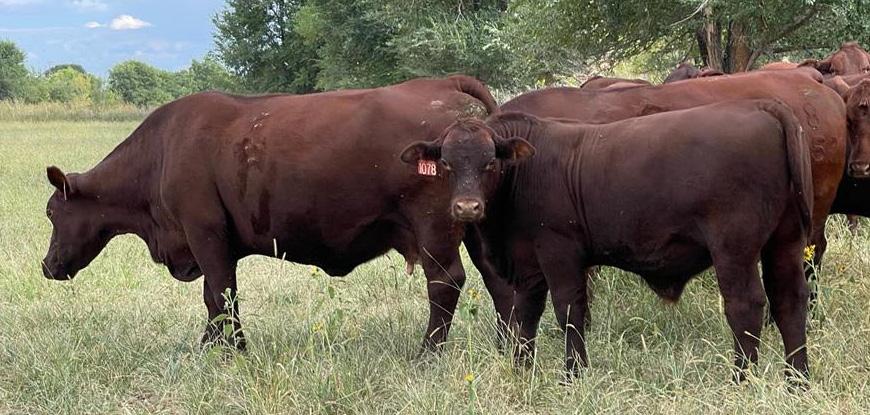
Dam, Red Doc Madre 2081


